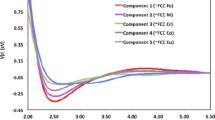Abstract
The totally anisotropic magnetic cooling compound, hydrated cerium magnesium nitrate, CMN, is treated at very low entropy values with the formalism of molecular-field theory. The magnetic phase-boundary line separating the ordered antiferromagnetic type region from the disordered paramagnetic region is well accounted for by the theory when compared with recent data of the Berkeley Low-Temperature Experimental Group. The ordered region refers to the canted antiferromagnetic or transverse magnetic field configuration of the Ce ions in CMN single crystals. One of the main experimental results refers to the temperature-scale functions obtained indirectly through largely arbitrary functions fitted to enthalpy-entropy data, treating simultaneously and indiscriminately both the ordered antiferromagnetic and disordered paramagnetic regions, with the data in the latter outweighing those in the former. The theoretical enthalpy-entropy function in the ordered range is in fair agreement with the corresponding data in absence of magnetic field with these data exceeding the calculated enthalpies. This may refer to the possible inclusion in the data of excitations in excess of the magnetic excitations alone accounted for by the theory. The entropy derivatives of the empirically fitted multi-parameter enthalpy-entropy functions define the indirectly derived temperature scales of strictly numerical significance at the very low temperatures. The molecular-field-theoretical entropy-temperature function, while approximate, is conceptually well grounded and may be preferable to, or at least competitive with, the indirectly derived Berkeley CMN temperature scales. There is fair agreement between them at the larger entropies approaching the zero magnetic-field critical transition entropy.
Similar content being viewed by others
References
T. J. Greytak, R. T. Johnson, D. N. Paulson, and J. C. Wheatley,Phys. Rev. Letters 31, 452 (1973); D. N. Paulson, R. T. Johnson, and J. C. Wheatley,Phys. Rev. Letters 31, 746 (1973).
A. R. Hudson, inPrinciples and Applications of Magnetic Cooling (North-Holland/American Elsevier, New York, 1972), pp. 109–119.
W. F. Giauque, R. A. Fisher, E. W. Hornung, and G. E. Brodale,J. Chem. Phys. 58, 2621 (1973).
R. A. Fisher, E. W. Hornung, G. E. Brodale, and W. F. Giauque,J. Chem. Phys. 58, 5584 (1973).
J. M. Daniels and J. Felsteiner,Can. J. Phys. 42, 1469 (1964).
G. O. Zimmerman, D. G. Abeshouse, E. Maxwell, and D. R. Kelland, inProc. 11th Int. Conf. on Low Temp. Phys. (St. Andrews, Scotland, 1968), p. 493; inLow Temperature Physics LT-13 (Proc. 13th Int. Conf. on Low Temp. Phys., Boulder, Colorado, 1972) (Plenum, New York, 1974); D. G. Abeshouse, G. O. Zimmerman, D. R. Kelland, and E. Maxwell,Phys. Rev. Letters 23, 308 (1969).
A. Zalkin, J. D. Forrester, and D. H. Templeton,J. Chem. Phys. 39, 2881 (1963).
L. Néel,Ann. Phys. [12]3, 137 (1948).
F. Keffer, inHandbuch der Physik, Vol. XVIII/2 (Springer, Berlin-Heidelberg-New York, 1966), pp. 95–103.
C. G. B. Garrett,J. Chem. Phys. 19, 1154 (1951).
L. Goldstein,J. Low Temp. Phys. 14, 471 (1974).
L. Goldstein,Phys. Rev. 188, 349 (1969).
Author information
Authors and Affiliations
Additional information
Work performed under the auspices of the U. S. Atomic Energy Commission.
Rights and permissions
About this article
Cite this article
Goldstein, L. Theory of a magnetic cooling system at very low temperatures. J Low Temp Phys 17, 385–401 (1974). https://doi.org/10.1007/BF00659082
Received:
Issue Date:
DOI: https://doi.org/10.1007/BF00659082




